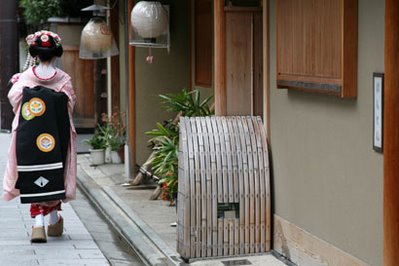 With October drawing to an end, I was determined to make a quick trek to Kyoto to secure tickets for Gion Odori, Gion Higashi's fall dance recital. I hadn't been to Kyoto since Gion Matsuri, and after three months I was itching for an excuse to get back.
With October drawing to an end, I was determined to make a quick trek to Kyoto to secure tickets for Gion Odori, Gion Higashi's fall dance recital. I hadn't been to Kyoto since Gion Matsuri, and after three months I was itching for an excuse to get back.Kyoto, like the rest of Japan, has been burried beneath a net of tangled electrical wires and encased in concrete. As I pulled into the station, staring out the smudged windows of the train, I wondered how I would have felt if this had been my first view of the old capital. Many foreigners must feel extrememly disappointed upon arriving in Kyoto, expecting to find old Japan, untouched by the rapid westernization consuming the world. Yet it is in the cracks and crevices of this seemingly cold, colorless, modern metropolis that the wonders of the ancient capital strive to survive, and wait to be discovered.
Kyoto has been my home away from home (away from home) since the first time I stumbled up the stairs of the Shijo Keihan subway station (after being stopped by a tiny little Buddhist nun who smiled and bowed and pinched my nose saying "Kawaii ne! Hana takai ne!" (Well aren't you cute? And your nose is so high!), and out onto the busy street, lined on one side by the Kamogawa River and the famous Minamiza Kabuki Theatre on the other. I know it better than the city I have been living in these past 2 and a half years, and probably know more about it than my hometown in the US. So as I weaved my way through the traffic of Japanese tourists filling crowded Kyoto station, I felt strangely enough as if I was home.
I walked along the Kamogawa River, wondering where the day would lead me. I always follow the river up to a certain point before loosing myself in the narrow lanes of Miyagawa-cho, one of Kyoto's five flower districts, where geiko live and entertain. I never expect to see much during the daytime-- perhaps a young maiko on the way to her lessons, casually dressed in a simple kimono-- but just walking through the quiet streets, lined with intricate wooden facades of ochayas (teahouses) and okiyas (where geiko live) is more than enough to make me happy. If I'm lucky, I'll hear an older geisha singing as she practices her shamisen, or see a maiko dressed for an appointment hurry into a taxi or down a narrow alleyway. These simple moments, when I am able to see my life in the light of a haiku, are what keep me madly in love with Kyoto.
The streets seemed quiet enough. It was still early, before noon, and little old women were washing down the concrete in front of their homes. The old man from the tiny little home-front market hurried back and forth across the street carrying big boxes of perssimons and apples, shouting out "Ookini!" to someone hidden in the shadows of his little shop. My eyes focused on the nameplates hung near the entrance of the okiyas, trying to decipher the kanji in the names of the maiko and geiko living there, until a sudden flash of intense color in the otherwise dull distance caught my eye. A maiko sliding out of her okiya and down the street, her long, trailing obi fluttering above her high wooden sandals, appeared like an apparition from another age. "What a great way to start the day," I thought as I watched her disappear into another teahouse, smiling to myself, happy to be "home".














